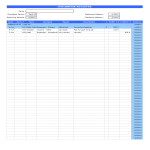Checkbook register sample templates
What is a Checkbook Register Spreadsheet and how to use a Checkbook Register Spreadsheet Printable?
A Checkbook Register Spreadsheet is a tool used to track and manage personal or business finances by recording all transactions made from a checking account. This includes deposits, withdrawals, and transfers, helping to keep an accurate balance and monitor spending.
Using a Checkbook Register Spreadsheet Printable:
Date: Ensure to enter the date of each transaction. This helps keep track of when each deposit, withdrawal, or transfer was made.
Transaction Details: Include detailed information about each transaction. This should consist of the check number (if applicable), the type of transaction (deposit, withdrawal, transfer), and a brief description or memo about the transaction.
Payee/Payer Information: Record the name of the payee or payer for each transaction. This adds clarity and helps in tracking who money is being paid to or received from.
Amount: Clearly state the amount of money for each transaction. Use separate columns for debits (withdrawals) and credits (deposits) to maintain clarity.
Balance: Continuously update the running balance after each transaction. This ensures that you always know the current balance of the checking account.
Categories: Categorize each transaction if necessary. This can help in budgeting and understanding where your money is going, such as groceries, utilities, rent, etc.
Reconciliation: Periodically reconcile your checkbook register with your bank statement. This helps to identify any discrepancies and ensures that your records match the bank’s records.
Signature: For additional security, you may want to sign off on each entry or page after reconciliation. This provides a record that you have verified the accuracy of the entries.
Save yourself time and effort by downloading this free Checkbook Register Spreadsheet printable. It is provided as a free downloadable template for your convenience and can be customized to fit your specific needs.
-
Free Printable Check Register
How do you create a simple checkbook register with Microsoft Excel? Check out this easy to use free printable check register in MS Excel format
View template -
Checkbook Register Template
How to make a Checkbook Register in Excel? An easy way to create your spreadsheet is by downloading this example Checkbook Register Excel spreadsheet template n
View template
Latest topics
- Formal Complaint Letter of Harrasment
How do I write a formal complaint about harassment? Check out these formal complaint letter of harrasment templates here! - Google Sheets Templates
How to work with Google Sheets templates? Where to download useful Google Sheets templates? Check out our samples here. - Letter Format
How to format a letter? Here is a brief overview of common letter formats and templates in USA and UK and get inspirited immediately! - IT Security Standards Kit
What are IT Security Standards? Check out our collection of this newly updated IT Security Kit Standard templates, including policies, controls, processes, checklists, procedures and other documents. - Excel Templates
Where do I find templates for Excel? How do I create a template in Excel? Check these editable and printable Excel Templates and download them directly!

